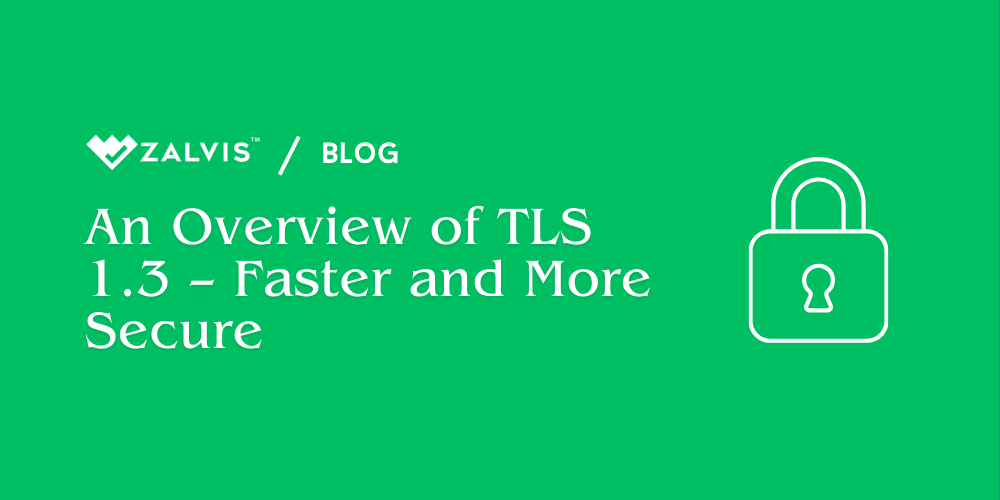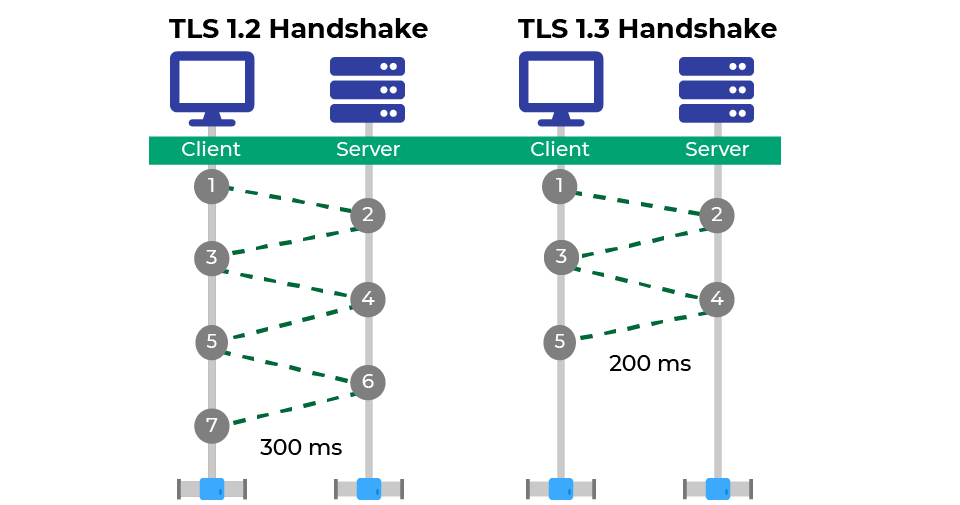Discover the advanced security and speed of TLS 1.3 in our comprehensive guide. Learn how TLS 1.3 enhances online privacy, reduces latency, and secures data with faster handshakes and robust encryption. Ideal for businesses and developers aiming to optimize secure communications.
The advent of the internet has reshaped nearly every facet of our daily lives, and with this transformation has come the need for greater security.
One of the most widely adopted protocols for securing online communications is the Transport Layer Security (TLS) protocol. From its initial release to the most current version, TLS 1.3, this protocol has undergone a series of updates to strengthen security and enhance performance.

TLS 1.3, the latest version of the protocol, marks a significant step forward, combining improved security measures with faster connection times. This article provides an in-depth examination of TLS 1.3, exploring its architecture, key features, security enhancements, and performance improvements.
What is TLS?
Transport Layer Security (TLS) is a cryptographic protocol designed to provide secure communication over a computer network. It is widely used in applications such as web browsers, email, instant messaging, and voice over IP (VoIP) services. TLS ensures the integrity, confidentiality, and authentication of the data transmitted between parties.
While TLS 1.2 remains in use, TLS 1.3 represents a leap forward in terms of both security and speed. Understanding this protocol and its improvements is crucial, especially for industries like finance, healthcare, and e-commerce, where data privacy is paramount.
Evolution of TLS: From SSL to TLS 1.3
The development of TLS originated from an earlier protocol known as Secure Sockets Layer (SSL). Here’s a quick look at the evolution:
- SSL 1.0, 2.0, and 3.0: SSL was developed by Netscape, but earlier versions were susceptible to various security flaws. SSL 3.0 was the last SSL version, and it became widely used despite inherent security weaknesses.
- TLS 1.0 and 1.1: Released in 1999 and 2006, respectively, these versions addressed SSL’s vulnerabilities but still left room for improvement.
- TLS 1.2: Introduced in 2008, TLS 1.2 added support for stronger cryptographic algorithms and hashing functions. While secure, it involves multiple round trips that slow down connection times.
- TLS 1.3: Ratified in 2018, this version not only addresses security concerns found in previous versions but also improves speed by reducing handshake latency.
Each evolution brought increased levels of security and performance, culminating in TLS 1.3.
Key Features of TLS 1.3
TLS 1.3 was designed with the twin objectives of bolstering security and enhancing performance. Some of its notable features include:
- Reduced Handshake Complexity and Latency:
• One of the most significant changes in TLS 1.3 is its reduction of handshake complexity. Unlike TLS 1.2, which requires two round-trips to establish a secure connection, TLS 1.3 typically needs just one.
• For repeated connections between the same client and server, TLS 1.3 can achieve a “zero round-trip time” (0-RTT) mode, which allows data to be sent instantly without waiting for a complete handshake. - Simplified Cipher Suites:
• In TLS 1.3, the cryptographic cipher suites have been streamlined. Only strong, modern algorithms are supported, eliminating obsolete and vulnerable options from previous versions.
• This streamlined approach reduces the chances of misconfiguration and simplifies the process of establishing secure connections. - Forward Secrecy by Default:
• TLS 1.3 enforces forward secrecy, a feature that protects past communications even if a private key is compromised in the future.
• This is achieved through the use of ephemeral keys, which are generated for each session, ensuring that previous communications cannot be decrypted. - Stronger Encryption Algorithms:
• TLS 1.3 mandates the use of modern encryption algorithms, such as AES-256-GCM and ChaCha20-Poly1305. These algorithms provide robust security and have been optimized for performance. - Improved Security Protocols:
• Vulnerabilities associated with older versions, such as BEAST, POODLE, and Heartbleed, have been addressed in TLS 1.3.
• By removing weak or outdated features like RSA key exchange and MD5 hashing, TLS 1.3 enhances overall security. - Enhanced Privacy for Session Resumption:
• In previous versions, session resumption was achieved through session IDs or session tickets, which could sometimes compromise privacy.
• TLS 1.3 introduces a new method using Pre-Shared Keys (PSK), which allows for fast reconnection without compromising privacy.
Understanding the TLS 1.3 Handshake
The handshake process is fundamental to any secure communication protocol, and TLS 1.3 introduces a more efficient method. Here’s how it works:
1. Single Round-Trip Handshake
In TLS 1.2, the handshake requires two round trips between the client and server, which adds latency. TLS 1.3 reduces this to a single round trip, as follows:

- The client initiates the handshake, offering supported cipher suites and cryptographic extensions.
- The server responds by selecting the best matching cipher suite and sending its public key.
- The client then generates a session key using the server’s public key, completing the handshake with a single round trip.
2. Zero Round-Trip Time (0-RTT) Handshake
For clients and servers that have previously communicated, TLS 1.3 offers a 0-RTT option, allowing encrypted data to be sent immediately:
- The client remembers the session parameters from a previous connection and starts sending encrypted data without waiting.
- The server uses cached session parameters to decrypt and process the data, resulting in near-instantaneous data transfer.
0-RTT mode is particularly advantageous for applications requiring fast reconnect times, such as video streaming or real-time messaging.
Security Enhancements in TLS 1.3
TLS 1.3 incorporates several security improvements over its predecessors. Key security enhancements include:
1. Mandatory Forward Secrecy
Forward secrecy ensures that even if encryption keys are compromised, past sessions cannot be decrypted. By enforcing forward secrecy by default, TLS 1.3 mitigates risks associated with long-term key compromise.
2. Removal of Insecure Algorithms
TLS 1.3 has eliminated algorithms that were found vulnerable or outdated, such as RC4 and 3DES, and weak hashing algorithms like SHA-1. Only strong, modern encryption methods are allowed.
3. Protection Against Downgrade Attacks
TLS 1.3 incorporates safeguards against downgrade attacks, where attackers trick servers into using older, less secure protocol versions. This ensures clients and servers stay on the most secure connection possible.
4. Enhanced Privacy
To protect against traffic analysis and fingerprinting attacks, TLS 1.3 encrypts more of the handshake messages than TLS 1.2, including the session ID and client random value.
Performance Improvements in TLS 1.3
One of the primary motivations behind TLS 1.3 was to reduce latency and improve performance. Key performance enhancements include:
- Faster Handshakes and Reduced Latency: By reducing the handshake process to a single round trip, TLS 1.3 significantly reduces connection times, making it faster than TLS 1.2.
- Zero Round-Trip Resumption: For returning clients, 0-RTT resumption means that data can be sent almost instantaneously, leading to improved performance for applications that require rapid reconnects.
- Reduced Bandwidth Consumption: TLS 1.3 reduces the overhead associated with encryption, lowering bandwidth consumption. This is especially beneficial for mobile users and applications with constrained network resources.
- Optimized for Modern Hardware: With support for AES-GCM and ChaCha20, TLS 1.3 is optimized for modern processors and can leverage hardware acceleration, enhancing performance even further.
Advantages of TLS 1.3 for Businesses
TLS 1.3 is particularly beneficial for businesses in security-sensitive sectors such as banking, healthcare, and e-commerce. Some of the notable advantages include:
- Increased Security: With stronger encryption and mandatory forward secrecy, businesses can protect sensitive customer data more effectively.
- Enhanced User Experience: Faster handshake times mean that users experience quicker page loads and smoother interactions.
- Reduced Infrastructure Load: The reduced bandwidth requirements and faster reconnections can decrease the load on servers, allowing businesses to optimize resource usage.
- Future-Proof Security: By adopting TLS 1.3, businesses are aligning with the latest security standards, ensuring compliance and readiness for future security demands.
Adoption Challenges and Considerations
While TLS 1.3 offers significant improvements, there are a few challenges that organizations might face during adoption:
- Legacy Systems Compatibility: Not all legacy systems are compatible with TLS 1.3, so businesses may face challenges in upgrading older infrastructure.
- 0-RTT Security Risks: The 0-RTT feature, while enhancing speed, can be vulnerable to replay attacks. Implementing it securely requires careful consideration.
- Vendor and Compliance Requirements: Certain regulatory frameworks may require specific encryption standards, so businesses should ensure that TLS 1.3 aligns with compliance needs.
Conclusion
TLS 1.3 is a transformative upgrade, enhancing both the security and performance of online communications. With faster handshakes, simplified cipher suites, and mandatory forward secrecy, TLS 1.3 offers a robust solution for today’s cybersecurity landscape. Its ability to provide stronger protection against attacks, coupled with improved connection speeds, makes it an essential tool for any organization looking to safeguard data while enhancing user experience.
For businesses and developers, embracing TLS 1.3 represents a commitment to modern security practices and readiness for an increasingly connected world. As the internet continues to evolve, protocols like TLS 1.3 will remain foundational to ensuring safe, efficient, and private digital interactions.
If you enjoyed this article, then you’ll love Zalvis's WordPress Hosting platform. Turbocharge your website and get 24/7 support from our veteran team. Our world-class hosting infrastructure focuses on auto-scaling, performance, and security. Let us show you the Zalvis difference! Check out our plans.



